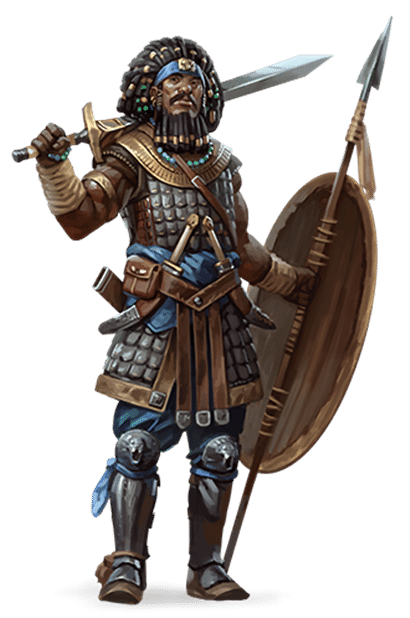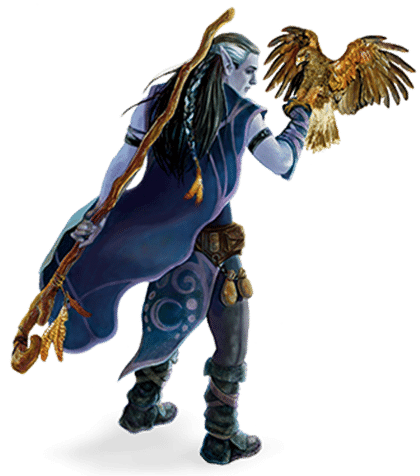D&D is wonderful because it allows you to do just about anything. But too many options can be intimidating to a brand new player, particularly when it comes to combat. It need not be this way. The reality is that 2-3 options will typically get you through 75% of combat situations. You don’t need to fret the rest at level 1.
So, let’s talk about some front-line character classes and what their 2-3 actions are. But, first, let’s talk briefly about movement. It does us no good to talk about what you’ll do if we don’t first talk about how you’ll get there.
Front-line characters like a Fighter, Paladin, Barbarian, or a Druid in bear form are designed to get in close with enemies. The obvious reason is because they hit things with swords (or claws), so they need to be within arm’s length.
The less obvious reason is because they hope to soak up the attention of enemies, not allowing them to run toward character classes like Sorcerers, who aren’t good at melee fighting.
So, how do you use use your movement to position your big, beefy barbarian to protect your feeble old wizard? Well, you keep 10 feet between you and another teammate, that’s how. And here’s why:
D&D has something called Opportunity Attacks. Basically, if you run past an enemy, they get a free swing at you, provided you ran within their 5 foot reach.
So, let’s say you position yourself 10 feet to the left of your teammate. You have 5 feet of reach to the right. Your teammate has 5 feet of reach to the left. Following me? That means that the goofy goblin that tries to run between you to get to your party’s wizard is going to trigger an opportunity attack from one of you.
That’s a simple movement tip to help you learn to control the battlefield. Now, let’s talk about some big, beefy characters and a couple introductory actions for them.
 Fighter: Who can I hit?
Fighter: Who can I hit?

A fighter is perhaps the most self-explanatory class in D&D. A player new to the fighter should enter combat asking themselves, “Who can I hit?”
Movement: Use your movement to get within arm’s reach of a beefy foe (same with Barbarian below). The best, uh, fighter in the game, the Fighter is built to kill. Here are the actions you should then typically choose from at level one:
- “I hit them with my weapon.” Fighters are good at fighting, so you’ll get bonuses to your d20 roll. But depending upon weapons used and if you want your fighter to be strong or quick, they may vary. So, our goal right now is not to calculate that math, it’s to use the same attack action over and over as a level 1 fighter as a fast way to learn. Hit ’em with your long sword every time and before you know it, the fighter class will click for you. Then layer on more creative options later.
- “I catch my breath.” Fighters will get hit and take damage. If you are in rough shape, you can use the Second Wind action as a bonus to regain some hit points, even at level 1.
Highlight the details of the above actions on your character sheet and use them throughout level 1 combat.
 Barbarian: What makes me angry?
Barbarian: What makes me angry?
A Barbarian is a big fighter who is prone to emotional outbursts. Specifically, they have an ability called “rage” that allows them to do more damage to enemies while taking less in return.
A level 1 Barbarian can only go into a rage twice a day, so you have to ask yourself, “What makes me angry?” Well, generally, if there are more bad guys than good guys, you Rage. And if the biggest bad guy is bigger than you, you Rage.
After that decision, there is just one more typical action a Barbarian makes:
- “I hit them with my weapon.” Same as Fighters, Barbarians are good at fighting, so you’ll get nice bonuses to your d20 roll. But depending upon different factors (like if you are in a Rage) they may vary. So, again, we’ll not calculate that math. But hit bad guys with your big axe every time. That’s how you’ll learn.
 Druid: How can nature empower me?
Druid: How can nature empower me?

With its combo of spells and wildshaping, a Druid can be a complicated class in D&D. But more often than not, most people like a druid because it allows the awesome thing of transforming into animals. A player new to the Druid should enter combat asking themselves, “How can nature empower me?”
Alas, you can’t Wild Shape at level one, which stinks quite frankly. So, in an effort to make lemonade of of lemons, I’ll give you a couple spell options that will allow you to gain expertise in that aspect of the character while you wait for the good stuff coming at level 2.
Movement: Note: Your move options shift with a Druid. While not as squishy as a Wizard at level 1, you still don’t want to linger in the area of hard-hitting enemies. But at level 2 and in bear form, that’s exactly where you’ll want to be.
- “I whip it good.” Cantrips are great because they can be cast time and time again without counting against a spell slot. Thorn Whip is a good combat cantrip because it does nice damage. The downside is it requires you to be close to an enemy (and even pulls them closer to you).
- “I heal a teammate.” While not as powerful a healer as a Cleric, Druids do get 1st Level healing spells. Your friends around the table will always appreciate the assist, so consider Healing Word as an option.
- “I make it harder for enemies.” Something Druids are great at is “controlling the battlefield,” meaning they have spells that hinder or slow enemies. Entangle, Faerie Fire, or even Thunderwave are nice control spell options for you to practice at level 1.
As you can see, Druid is not a beginner class. You’ll play one way at level 1, then will likely shift tactics dramatically at level 2.
Again, D&D has 300 pages of rules, which makes it intimidating for new players. But, while the above are just the absolute basics, it’s helpful to take a deep breathe and realize that 75% of combat can be handled with just a couple actions that are used over and over.
This repetition serves to help you learn the basics of the game and your character’s combat style. That’s a whole lot more than nothing. But the best thing? Hitting things with axes and entangling them with vines is a lot of fun.
D&D is wonderful, but it can be intimidating. So let’s knock down any barriers that might prevent someone from loving their first few times playing. Share this with any brand new D&D players you know, regardless of what class they are considering:
- Barbarian: “What makes me angry?
- Fighter: “Who can I hit?”
- Druid: “How can nature empower me?”
- Paladin: “Who can I protect?”
- Cleric: “How may I help?”
- Ranger: “Who here is my sworn enemy?”
- Wizard: “What spells have I learned?”
- Sorcerer: “What gets my blood flowing?”
- Rogue: “Where’s the vulnerability?”
- Monk: “How is my speed best utilized?”
- Warlock: “Who can I blast?”
- Bard: “Who can I inspire?”
Movement Tips: Think 35+ | 10 feet Between | Break it Up | Use that cover! | Only Fools Rush In | Get in the Face
You can buy the D&D Players Handbook here.

